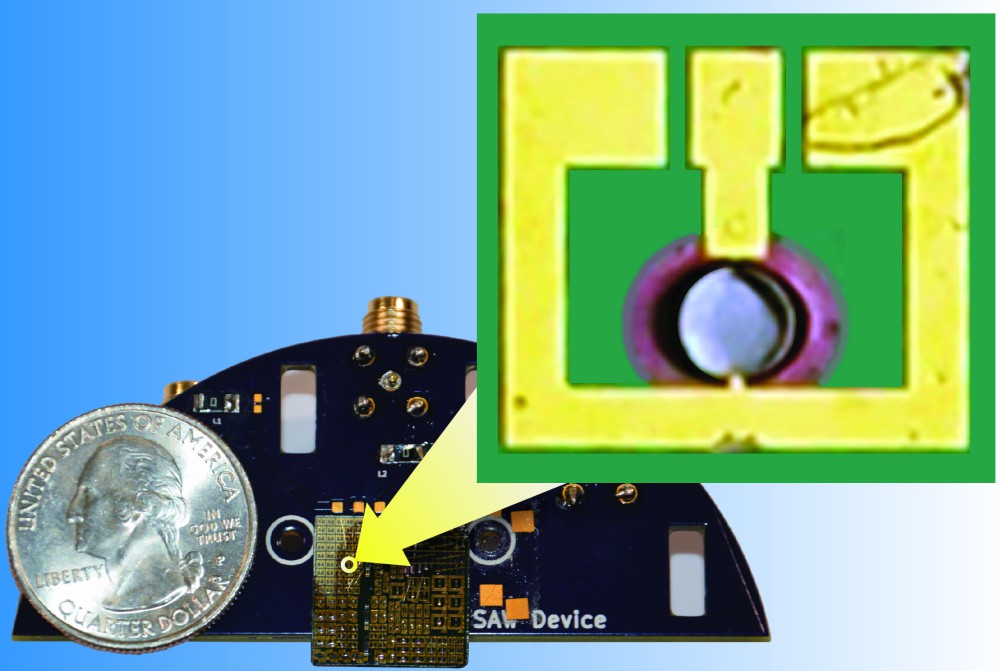When it comes to military and consumer electronics, smaller is often better, and the Air Force Research Laboratory’s revolutionary new antenna design is promising to make military electronics much better.
Researchers at the AFRL Materials and Manufacturing Directorate, in partnership with Northeastern University, recently developed an ultra-compact antenna that uses a whole different approach in transmitting and receiving signals. This breakthrough could be a big step in the miniaturization of many military and commercial communication systems.
Typical antennas rely on size to function effectively in the electromagnetic spectrum. If the antenna is not long enough to resonate at the proper frequency, the antenna will not be able to transmit or receive the desired electromagnetic waves efficiently. Over the years, impressive strides have been made in antenna miniaturization, with cellphones being a prime example. However, the quality of antennas degrades as they become smaller, hence the need for cellular carriers to put in place large numbers of cellular antenna towers to ensure adequate phone reception for consumers.
“We identified ultra-compact antennas as the critical last step in true device miniaturization,” said Dr. Brandon Howe, AFRL materials scientist. “Researchers had successfully shrunk most electronic components, but the true miniaturization of antennas was still a missing piece.”
The size of an efficient miniature antenna is typically about ten percent of the wavelength, whereas the ultra-compact AFRL antennas are as small as fractions of a percent of the wavelength. As a result, microwave antennas that were previously approximately a half inch can now be reduced to an object smaller than a flea (less than one millimeter). Although not an immediate replacement for small antennas, this miniaturization could be an important step toward incorporating antennas into a number of applications for which they were previously impractical.
These ultra-compact antennas represent a whole different approach to this type of technology. Instead of using an electrically-conductive material to sense the electric field of microwaves, these antennas use special insulating materials, called “multiferroic composites.” These materials are composed of magnetostrictive materials, which convert magnetism to strain, and piezoelectric materials, which convert strain to voltage converting material. Using the multiferroic composites allows the ultra-compact antennas to function by sensing the magnetic field of microwaves.
“We miniaturized the antennas by borrowing a trick from acoustic filters in cellphones, which convert microwave voltages to strain waves. Strain waves travel much slower than the speed of light, so by doing this, we are able to shrink the wavelengths while keeping the frequency the same. This allowed us to make the antennas much smaller,” said AFRL materials scientist Dr. Michael McConney.
He added that by coating conventional bulk acoustic wave filters with a magnetic material, these slower strain waves can be converted into radiation, which enabled them to break the inefficient scaling laws associated with shrinking typical antennas to very small sizes.
According to the researchers, this antenna represents a new way of thinking. By combining material technologies in a new way, they were able to reimagine how an antenna functions.
This new approach allowed the AFRL and Northeastern University research team to reduce the size of an antenna by over 90 percent, dramatically changing their potential design space. As McConney explains, this new design allows antennas to retain much more of their functionality compared to traditional antennas scaled down to the same size. This development could result in smaller devices including wearable antennas, bio-implantable and bio-injectable antennas, smart phones, and wireless communication systems, to name a few.
“The miniaturization of military electronics is of significant benefit to the warfighter, not only in terms of device size, but in transportability, space requirements, weight, and many factors,” said Howe. “It can allow us to fit more into a given space, whether that be in a field pack or on an aerial platform. It gives us greater capability in a smaller space.”
The team plans to continue its research by working toward matching the ferromagnetic resonance to the acoustic (strain) resonance, as well as by integrating a new low-loss, highly-sensitive magnetic material that the group has pioneered. By doing so, the researchers hope to further enhance the efficiency of the antenna.
The team’s research was recently published in the journal Nature Communications, and can be viewed more in depth at https://www.nature.com/articles/s41467-017-00343-8.
Photos: U.S. Air Force photo/Michael McConney/David Dixon
Source: Press Release


